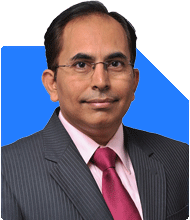50-year-old looking to Retire: Can 2 Crores Get Me Rs 1.5-2 Lakh Monthly Risk-Free?
Ramalingam Kalirajan |10902 Answers |Ask -Follow
Mutual Funds, Financial Planning Expert - Answered on Sep 17, 2024
He has an MBA in finance from the University of Madras and is a certified financial planner.
He is the director and chief financial planner at Holistic Investment, a Chennai-based firm that offers financial planning and wealth management advice.... more

How to plan for retirement with 2cr corpus amount to get 1.5 to 2 lacs monthly income without any risk
Assessing Your Retirement Goals
You aim for Rs 1.5 to 2 lakh monthly income.
You want a risk-free investment approach.
The Rs 2 crore corpus should last for your lifetime.
The plan must account for inflation and future needs.
Key Insight: Your current corpus is solid, but it needs a structured approach to generate a sustainable income. Risk-free instruments are necessary, but returns should also keep pace with inflation.
Strategy 1: Fixed Deposits (FDs)
Fixed Deposits in banks and non-banking financial companies (NBFCs) offer risk-free returns. They are ideal for generating stable income, especially for retirees.
Interest rates for FDs range between 6% to 7%.
You can choose monthly or quarterly interest payouts.
Spread your FDs across different banks to diversify and reduce risk.
Key Action: Invest a part of your Rs 2 crore in FDs for guaranteed returns. Opt for monthly payouts to ensure a steady flow of income.
Strategy 2: Senior Citizen Savings Scheme (SCSS)
If you are 60 years or above, the Senior Citizen Savings Scheme is a great option. It provides both safety and decent returns.
The SCSS offers an interest rate of around 8%.
You can invest up to Rs 30 lakh in SCSS.
The scheme has a 5-year tenure, extendable by 3 years.
Key Action: Invest the maximum allowed amount in SCSS for higher returns and capital safety.
Strategy 3: Monthly Income Schemes (MIS)
The Post Office Monthly Income Scheme (POMIS) is another reliable source of risk-free income.
The current interest rate is around 7.5%.
You can invest up to Rs 9 lakh jointly or Rs 4.5 lakh individually.
Interest is paid monthly, making it ideal for regular income.
Key Action: Use this scheme to generate steady, monthly income with zero risk.
Strategy 4: Debt Mutual Funds
While you prefer risk-free options, some debt mutual funds provide higher returns than FDs with minimal risk. Debt funds invest in government securities, corporate bonds, and money market instruments.
Short-term debt funds or liquid funds are safe options.
They provide better post-tax returns, especially for those in higher tax brackets.
Returns can range between 5% to 8%, depending on the fund type.
Key Insight: Debt mutual funds are not entirely risk-free but offer better returns compared to FDs. Opt for funds with low volatility.
Strategy 5: Pradhan Mantri Vaya Vandana Yojana (PMVVY)
This is a government-backed scheme for senior citizens that offers guaranteed returns.
The scheme offers around 7.4% interest per annum.
You can invest up to Rs 15 lakh.
Payments can be received monthly, quarterly, or yearly.
Key Action: Invest in PMVVY for guaranteed, pension-like income.
Strategy 6: Laddering Your Investments
Instead of investing all your money in one scheme, consider laddering. This ensures liquidity and better returns over time.
Spread your investments across various tenures and instruments.
Keep some FDs for short term and others for long term.
Use SCSS, MIS, and debt mutual funds to create multiple income streams.
Key Action: Laddering your investments will help manage interest rate changes and inflation while ensuring liquidity.
Managing Inflation Risk
Inflation erodes the purchasing power of your money over time. Although your goal is risk-free investment, it’s important to keep pace with inflation.
Debt mutual funds or bonds can help in generating higher returns, which can offset inflation.
Consider reinvesting some of your returns to maintain your corpus.
Key Insight: A balance between completely risk-free instruments and low-risk debt funds can protect against inflation without exposing you to market volatility.
Tax Planning for Retirement Income
Taxation can affect your post-retirement income. Planning your investments in a tax-efficient manner is crucial.
Interest from FDs, SCSS, and PMVVY is taxable as per your income tax slab.
Debt mutual funds offer better post-tax returns, especially if you hold them for over three years (long-term capital gains taxed at 20% with indexation).
Key Action: Keep your tax liability in mind when choosing investment instruments. Rebalance your portfolio if needed to ensure tax-efficient income.
Withdrawal Strategy for Rs 2 Crore Corpus
To ensure your Rs 2 crore corpus lasts for your lifetime, a disciplined withdrawal strategy is essential. You should avoid withdrawing more than 6% to 8% of your corpus annually to preserve the capital.
If you withdraw Rs 1.5 lakh to Rs 2 lakh per month, this amounts to Rs 18 lakh to Rs 24 lakh annually.
Based on your corpus of Rs 2 crore, this is a 9% to 12% withdrawal rate. You may need to adjust the monthly withdrawal to preserve capital.
Key Insight: A well-balanced withdrawal rate will help sustain your corpus and provide income for a longer period.
Final Insights
Planning for a risk-free retirement with Rs 2 crore is achievable with the right strategies in place. By diversifying across risk-free instruments like FDs, SCSS, and POMIS, and considering tax-efficient debt funds, you can enjoy a steady monthly income of Rs 1.5 to 2 lakh.
It is important to manage your tax liability, factor in inflation, and withdraw in a disciplined manner to make your retirement corpus last. Regularly review your investments to ensure they continue to meet your goals.
Best Regards,
K. Ramalingam, MBA, CFP,
Chief Financial Planner,
www.holisticinvestment.in
You may like to see similar questions and answers below
Dr Nagarajan J S K |2577 Answers |Ask -Follow
NEET, Medical, Pharmacy Careers - Answered on Jun 17, 2025
Ramalingam Kalirajan |10902 Answers |Ask -Follow
Mutual Funds, Financial Planning Expert - Answered on Jun 18, 2025
Janak Patel |72 Answers |Ask -Follow
MF, PF Expert - Answered on Jul 16, 2025
Radheshyam Zanwar |6751 Answers |Ask -Follow
MHT-CET, IIT-JEE, NEET-UG Expert - Answered on Dec 19, 2025
Radheshyam Zanwar |6751 Answers |Ask -Follow
MHT-CET, IIT-JEE, NEET-UG Expert - Answered on Dec 19, 2025
Samraat Jadhav |2514 Answers |Ask -Follow
Stock Market Expert - Answered on Dec 18, 2025
Reetika Sharma |432 Answers |Ask -Follow
Financial Planner, MF and Insurance Expert - Answered on Dec 18, 2025
Reetika Sharma |432 Answers |Ask -Follow
Financial Planner, MF and Insurance Expert - Answered on Dec 18, 2025
Reetika Sharma |432 Answers |Ask -Follow
Financial Planner, MF and Insurance Expert - Answered on Dec 18, 2025
Samraat Jadhav |2514 Answers |Ask -Follow
Stock Market Expert - Answered on Dec 18, 2025

Kanchan Rai |648 Answers |Ask -Follow
Relationships Expert, Mind Coach - Answered on Dec 18, 2025
Kanchan Rai |648 Answers |Ask -Follow
Relationships Expert, Mind Coach - Answered on Dec 18, 2025
Anu Krishna |1754 Answers |Ask -Follow
Relationships Expert, Mind Coach - Answered on Dec 18, 2025
























